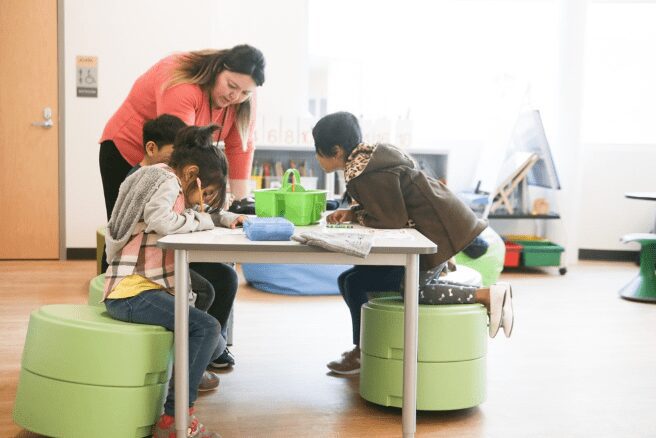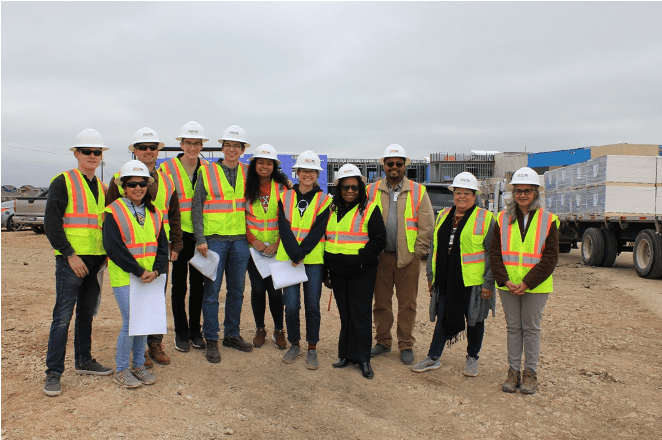
At Austin ISD, sustainability is a driving force behind our mission to provide a high quality and comprehensive educational experience that challenges and inspires students to make a positive contribution to our world. Our school communities seek to preserve and improve the environments where we work, live and play by building a culture of environmental awareness and action. As a district-wide initiative, AISD is working to bring the latest green building innovations and technologies to all of our schools.
Since 2004, all new schools and major renovation projects have worked to achieve high ratings from Austin Energy Green Building (AEGB). AEGB’s mission is to create a sustainable future for the building industry by informing city policies and energy codes and encouraging public demand for sustainability. AEGB was founded in 1991 as the first rating system in the U.S. for evaluating building sustainability and it inspired many cities to follow. With thirty-one AEGB certified buildings and counting, AISD is proud to contribute to Austin’s environmental and sustainability goals, while simultaneously teaching our students the importance of responsible stewardship.
AISD works hard to provide all students with a hands-on learning experience that provides an opportunity to engage in real-world scenarios, helping them to become leaders and change-makers within their community. AISD has teamed up with EcoRise, the University of Texas School of Architecture, and BLGY Architecture to design and pilot an innovative Green Building Internship Program for Central Texas high school students. The internship program seeks to create career opportunities for historically underrepresented students in the field of green building, including female students and students of color.

Just this past year, Akins High School students in Mr. John Sayce’s Scientific Research and Design course learned about green building and sustainability through EcoRise’s LEED (Leadership in Energy and Environmental Design) Prep Curriculum, which also prepares them to take the LEED Green Associate exam. They interned with BLGY Architecture professionals who are designing the new Blazier’s 4-6th Grade School, a modernization project of the 2017 Bond Program. Students gained insight on green buildings through LEED workshops, construction site tours, and Lunch-and-Learn events with industry representatives. With the integration of research, tours, collaboration, presentations, and engaging conversations with the architects, the students experienced a window into the realities of the industry with practicing green building professionals.
Before starting the construction projects included in the 2017 bond program, AISD updated its Educational Specifications or Ed Specs, which are design standards and concepts used by school districts to guide new school facility construction and major space renovations to create engaging and effective learning environments. AISD’s Ed Specs now integrate sustainable design so that the district’s facilities not only conserve resources through a reduced reliance on water, electrical and gas utilities, but also enhance learning outcomes. As a part of the bond program, every modernization project will be equipped with smart design features designed to minimize AISD’s ecological footprint.

For example, the newly-opened T.A. Brown Elementary School features the district’s first thermal ice storage system, which allows the district to efficiently moderate the facility’s temperature and reduce overall energy consumption. As a green school rooted in STEAM and outdoor learning, the integration of nature into the learning environment promotes academic achievement through hands-on, experiential learning and enhances the cognitive and emotional processes important for learning. The modernized school features a nature loop trail, water cistern, dry creek bed, learning pond, nature play, native pollinator plants, goat pen, and heritage trees for enriched learning across all subject areas.
While each school will receive unique sustainability features tailored to their school’s goals and environment, every school built from the 2017 bond will incorporate all of these green initiatives:
- Indoor Water Use Reduction: Water-efficient plumbing fixtures including faucets, toilets and showers save water and reduce demand on the city’s water infrastructure.
- Outdoor Water Use Reduction: Schools will save water by using water-smart plants, efficient irrigation equipment and reclaimed water that is safe for outdoor use.
- Native and Adaptive Landscaping: Each landscape features carefully chosen water-smart plants that thrive in Austin’s climate and attract local pollinators.
- Light Pollution Reduction: The outdoor light fixtures focus light where needed for safety while protecting the beauty of the night sky and the habitats of nocturnal wildlife.
- Energy Conservation: To reduce the energy use and save money, all schools have efficient air conditioning, heating and lighting systems, daylight and occupancy sensors, and high-performance windows.
- 100% LED Lighting: High-efficiency LED lighting is mercury-free and long-lasting. The lighting control systems use daylight sensors to automatically dim the lights to provide comfortable lighting levels and reduce energy use.
- Health and Sustainability Materials: Each school has thoughtfully selected materials that provide a healthy indoor environment for our students, teachers, and staff. Many of these materials are made with recycled and Texas-sourced content.
- Local and Regional Produce: All cafés use fruits and vegetables from local farms, providing healthy meals for students, and promoting environmentally-sound agricultural practices.
- Green Cleaning: The products and equipment used to clean our school protect building occupants and the environment from potentially hazardous chemicals and contaminants.
- Outdoor Learning: Outdoor learning areas will cater to the environment and vary by campus. Examples of outdoor learning are a nature loop trail, water cistern, dry creek bed, learning pond, butterfly garden, nature play, native pollinator plants, and heritage trees for enriched hands-on learning in nature across all subject areas.
We’re excited to grow our sustainability efforts through the modernization projects. Learn more about AISD Sustainability and find out how to get involved with the AISD Environmental Stewardship Committee. Thank you for your support as we work to create 21st-century learning spaces for all students and continue to reinvent the urban school experience!

